YOUR CART
- No products in the cart.
Subtotal:
$0.00

Eighteen years’ worth of artist’s paint rags and a camper van were the stimulus for Patricia Brown to find a new craft that she could do in a small space.
Having salvaged old paint-daubed cloths from a bucket in her New York studio, Patricia purchased the whole gamut of colours in the DMC embroidery floss range and proceeded to spend several weeks merging with the essence of her rags. She set off on her travels with an eagerness to stitch, despite many years of absence from the craft.
With inspiration along the way from different stitching styles, artists, and even a spiritualist choral group, Patricia taught herself to integrate her gestural approach to abstract painting into her hand stitchery. It resulted in her Remnants series of stitched textiles.
Patricia Brown: Recently my husband and I purchased a small camper van so we could explore the world of birds in Florida during the winter months. In this adventurous spirit, I searched for a new craft that I could carry on my journey.
I hand sewed small birds from old handkerchiefs and embroidered little felt badges of the birds we were admiring throughout our travels. My confidence in making art through stitching grew as I drew and crafted each bird. I didn’t have to know a library of sophisticated stitches to be successful; I could apply my drawing and painting skills. I enjoyed the stillness, working with one little stitch at a time, anywhere I wanted.
I decided to build on this by researching approaches to embroidery beyond the ‘sampler’ roots I had been taught as a child. That’s when I remembered Boro cloth.
A few years ago, I saw Chiharu Shiota’s ‘Traces of Memory’ at the Mattress Factory in Pittsburgh. In her overwhelming, yet delicate, installation I found the thread of her story and the power of thread to voice story as I walked through this house full of haunting rooms.
More recently I found Junko Oki, a contemporary Japanese artist who stitches in an embellished Boro-related style.
Boro cloth is a form of hand sewn mending done by Japanese peasants in tending to clothing passed down through generations. In Boro, layers of indigo patches hold threadbare fabrics together, to preserve the garment so it can be worn over and over again. Repair upon repair created design out of necessity. What had once been a sign of poverty, became an object of beauty.
Oki says: ‘When you are stitching, you can go sideways if you like. Even if you end up with a tangled-up thread, you don’t have to cut it off, you can leave it to create a new pattern. In other words, the path is endless and you can keep on going – no turning back.’
I am amazed by Oki’s raw, spontaneous approach and work to incorporate this freedom into my Remnants.
I was never particularly good at making the ‘perfect’ stitch my class leader wanted, so Boro suited me down to the ground.
Boro freed me with its simple, often uneven, stitches which appeared haphazardly placed.
Having found my stitch style, I now just needed something to stitch onto. I knew that I enjoyed working on found fabrics because they already held energy. As I looked around, I remembered that I had been saving my painting rags for years. I just could not throw them away as I found them striking, quite apart from the paintings they had helped me to create. I pulled them out of their buckets and quickly placed embroidery hoops in places that drew my attention.
I filled the studio with these colourful rags. I experimented with various sizes and placements of the hoops, letting the rags dangle off the edges.
I decided I was going to stitch onto my rags! I was exhilarated knowing I was discovering something autobiographical and historical, while simultaneously revealing something new.
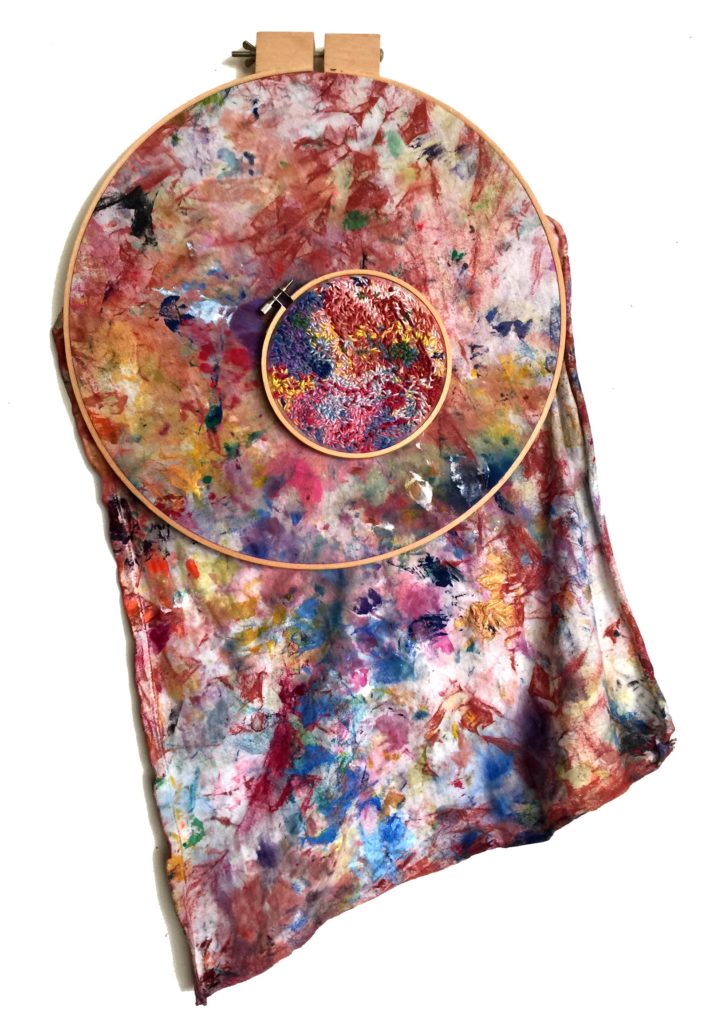
When I began my Remnant series, I was stitching into colourful rags, considering the design elements. Over time, I began to understand how these scraps of cloth related to me personally, narratively and symbolically.
My old splattered, smudged and torn paint rags contained dynamic markings that record years of my studio practice.
My rags had been used over and over again and I had stowed them away in a paint bucket, never quite sure what I would do with them. These paint rags were once worn as t-shirts – from a vestige of shows and events that I had been a part of since 2001 (Remnants 1 and 2). Some had performed functional tasks such as cleaning my brushes, hands, tabletops, easels and clothing. They hold traces of paint that stained them as I smudged, wiped, smeared, and removed paint from the surfaces of abstract paintings.
Most artists would have discarded these – their cleaning cloths – as rubbish, but I could not.
With certain Remnants, I recalled studio experiences and paintings that had been forgotten. Transforming them into artworks became an exploration of self: a way of finding beauty in each remnant was an act of finding beauty in myself. I found beauty beyond the surface – it was in history, story, memories, smudges, marks, scars and hidden places. They are a part of me, and I am a part of them.
Once I was able to see myself in the Remnants, I was able to see others. While working, I often listened to the daily news, cringing at our leadership’s poor treatment, rejection and belittling of ‘unwanted’ people.
My stitched rags began to represent the ‘dregs’, ‘fags’, ‘rubbish’, ‘leftovers’ and ‘cast-offs’ of our society, who all deserve to be recognised and cared for.
Now I stitch hope for all to be seen for their inherent beauty. To spread this message, I offer ‘Remnants are Beautiful’ stickers to gallery viewers.
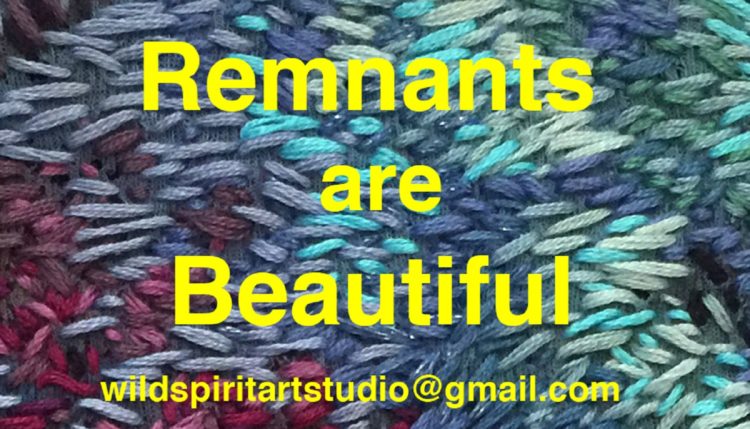
Every summer for ten years, I studied with artist mentors Timothy Hawkesworth and Lala Zeitlyn through drawing workshops at Art New England. They emphasised painting from the heart, being in the moment, entering the canvas bravely and sincerely, and trusting how the body responds.
As I worked, I asked myself: ‘Am I lifted by this approach?’ And if the answer was yes, I kept going.
Whilst stitching the Remnant series, I had been reading Clarissa Pinkola Estes’ book Women Who Run With the Wolves with a group of artists. Each fairy tale calls for us to examine various challenging archetypes within ourselves and in the culture. Through this deep understanding of character and metaphor, I was able to look at my paint rags as narrative symbols.
Years after their useful life, these rags are my teachers.
In the series, I integrated my gestural approach to abstract painting into my hand stitchery.
I have an agreement that, as I stitch, I will follow each rag’s structure and design. I accept the rag ‘as is’ and never add paint to it. Each rag demands a different colour scheme and an animated approach to the direction, length and shape of each stitch. In honouring the formation of each rag, I locate beauty in what would ordinarily be discarded.
The first step in each Remnant was to determine the area to focus on within the hoop.
I looked for the section of each rag that lifted me with its dramatic line, shape and colour relationships. I explored many strategies to decide how to let the fabric drape off the rim: hoops within hoops, multiple hoops, fabric hanging straight, and hanging off to one side. I played with the captured remnants in my studio for weeks before making final commitments. Eventually, the specific composition held a certain interest and tension and it felt right – I kept going.
The second step was to find the colour scheme that worked best for each Remnant. I purchased every one of the 400 colours in the DMC embroidery floss collection – the choice of a very particular shade was vital. It was like getting my first box of 64 crayons as a child. I wound all the floss onto bobbins and stored them in plastic containers. When selecting colours for a rag, I surrounded the rag with these containers and began pulling colours, gathering a ring of them for each rag. At one point I filled my entire studio with rags and their corresponding bobbins, each a unique colour scheme. I sat with them for weeks before the stitching began. When I show this work, I hang up a Remnant Bobbin Rack and invite viewers to match the colour bobbins to the Remnants, encouraging them to look very closely.
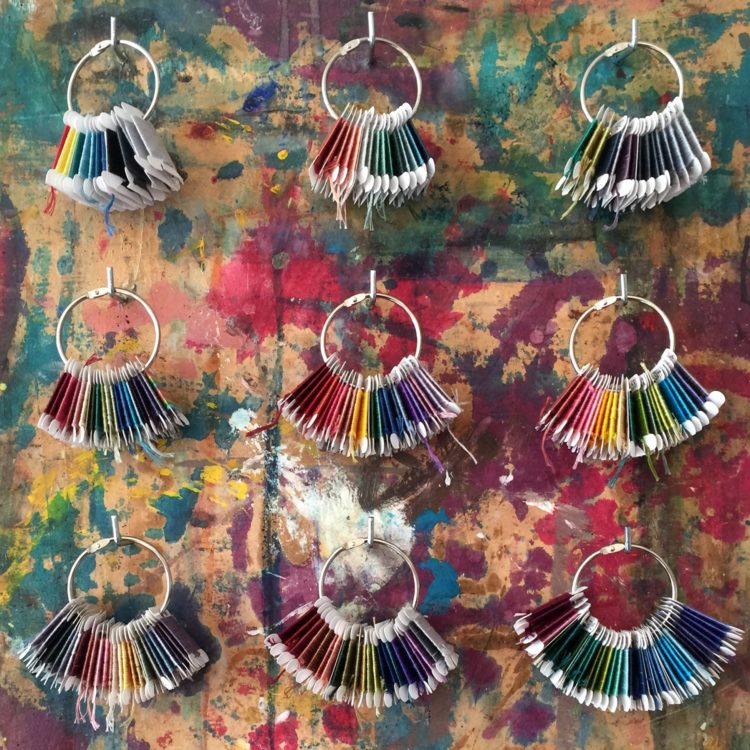
Once I selected the colour scheme, I gazed at the paint markings within the hoop and looked for the big picture. What kind of movement dominated? What was the counter-current? What required big marks? Small stitches? What direction did each stitch require? What areas needed stitching? What areas should I leave alone? How did this focus area interact with the rest of the rag outside of the hoop?
I began with the design aspect I wanted to emphasise, then all other stitches supported it. This is exactly how I paint. Once I see a big picture, I work spontaneously trusting each small decision along the way. I revel in stitching – the real joy in this ‘one little stitch at a time’ process.
Occasionally the big picture in a rag suggested an image in the real world to me. In Remnant 11, Overlook Falls the colour scheme and the long vertical format with small angled hoops looked like a waterfall to me. I worked with this idea to complete the image, letting the threads flow out from the bottom.
I invite viewers to create mindscapes through my abstract arrangement of colourful threads and gestural stitches.
I presented the Remnant series in a show titled Textures at the State of the Art Gallery in Ithaca, NY. Through research, I discovered that ‘text’, from the Latin verb ‘texere’, means to weave and intertwine. My friend, novelist and poet Lisa Harris – a constant inspiration to me – says: ‘Words are chosen and discarded, lined up, rearranged or thrown away while I work to create textured landscapes for the reader or listener to enter. Readers or listeners participate in a symbiotic relationship with the words a writer crafts, creating pictures in their minds.’
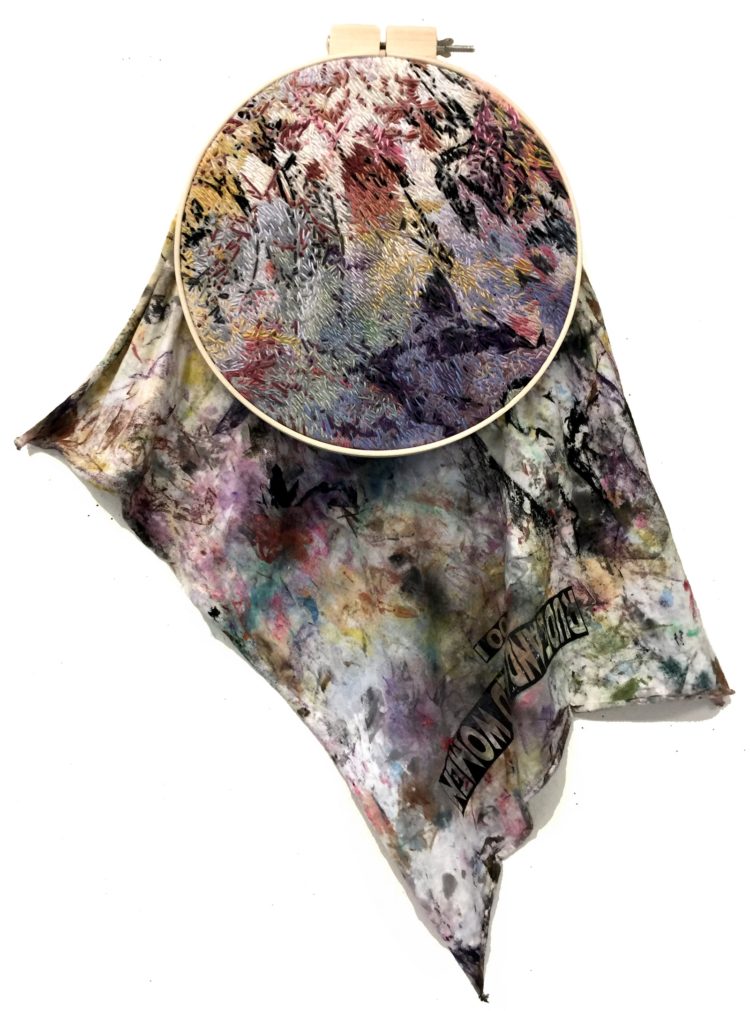
I stitched Remnant 4: Jubilee while on tour with the Dorothy Cotton Jubilee Singers, a choral group dedicated to the preservation of Negro spirituals. We travelled down to Goldsboro, North Carolina, the birthplace of civil rights leader Dorothy Cotton, to honour her life in her hometown.
Dr William J Barber II and the Greenleaf Christian Church community welcomed us and spoke passionately about the hope and faith that spiritual songs give our spirit. He described how the songs must be sung with the whole body and told us that they were sung in mass meetings before the descendants of enslaved Africans marched and were beaten on the Edmund Pettus Bridge. He said that the songs brought them together so that they became one person. He used a term ‘to worry the line’ meaning that the singing of the words introduced something extra into the song.
I stitched for two days on this paint rag as we drove south, simply following the colours in the cloth while I watched the landscape change outside the window.
On the return, I ‘worried’ the colours. I spontaneously stitched darker, lighter, brighter, duller, complementary and analogous colours that hung around those present on the rag. I layered in the energetic loving spirit of singing together, Dr Barber’s words, and the palpable joy of everyone present as we honoured Dorothy Cotton. I worked until the colours vibrated in the same way as the church did while we ‘sang out and marched on’.
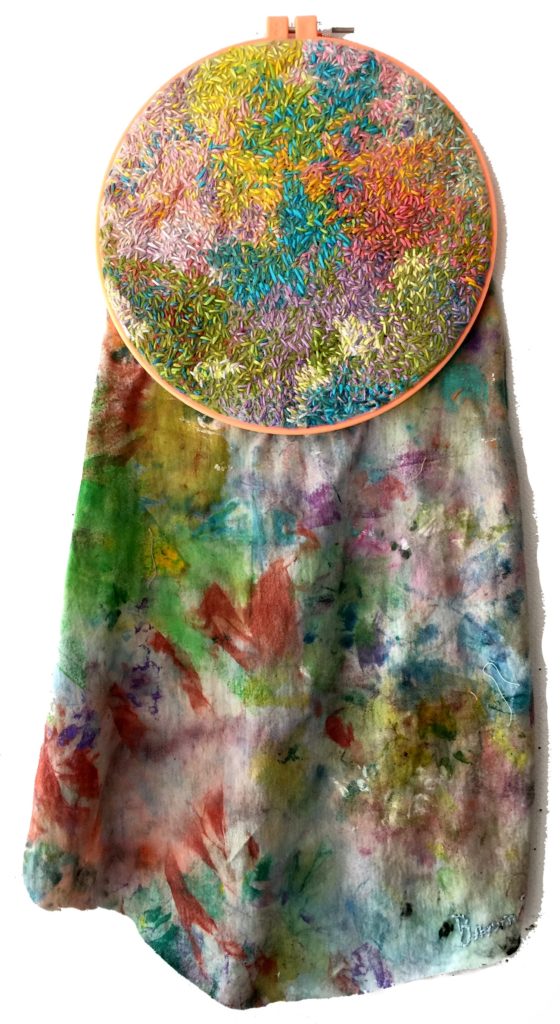
I grew up in a very creative rural household; the handmade life was highly valued. My father was a creative farmer, builder, artist, gardener and cook. My mother filled me with stories. My mother, grandmother, and aunts were constantly sewing, knitting or stitching clothing or decorative pieces. My grandmother sewed my Barbie doll clothes.
Quilts were handed down from many older generations. All family members pitched in to create our holiday decorations and gifts.
My most memorable interest in fibre was macrame – I made belts, owl necklaces, plant hangers, wine bottle holders, and decorative hangings for all of my friends and relatives. I can’t say that I saw all this creative work as art – it was how we enjoyed life and shared with others.
Most of the strong women in my life were teachers. In high school, I took several art classes and in my senior year became a teaching assistant in the middle school art class. I began to see the importance of my creative upbringing and went to college to study art education.
I have guided thousands of children in developing their creative lives. I spent most of my career at the high school level, where my goal was to help each student develop personal ideas through a series of related artworks. I constantly researched new ways of working to support the processes of each individual. While teaching, I challenged myself in the same way – and I have done ever since.
Read about other artists who have recycled and reused materials in their textile art.
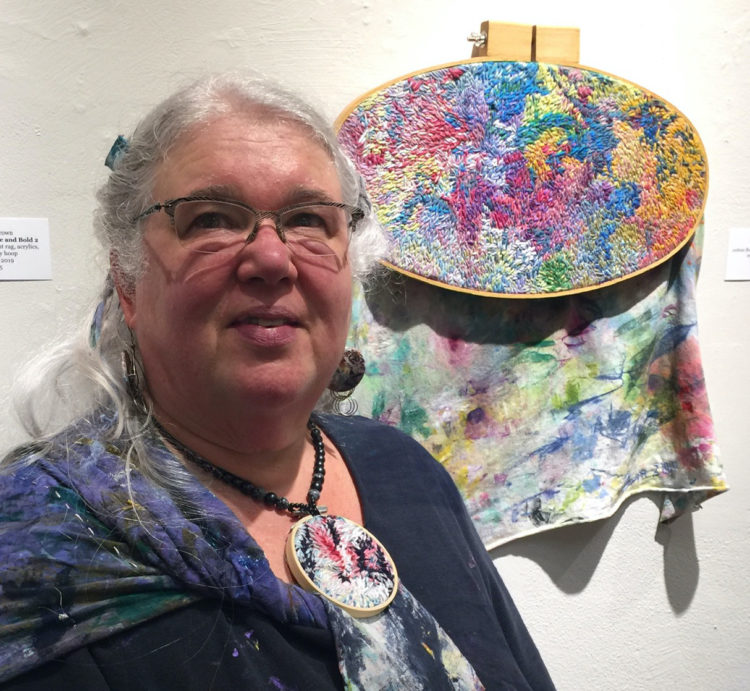
Patricia has encouraged would-be textile artists and embroiderers to have a go, telling us that you do not have to be an expert to embark on the journey that leads you into a new medium. She points out that:
Patricia is an Artist Member of State of the Art Gallery in Ithaca, New York and is known for her exhibitions of drawings, paintings, collages and mixed media assemblages in galleries and museums across New York.
She taught visual art in New York State public schools where she was awarded Art Educator of the Year. She has co-authored a book Traveling Through Glass with her close friend and poet, Lisa Harris.
She now works as a creative art coach and educational consultant in the visual arts.
Website: www.soagithaca.org/patricia-brown
What do you think about the techniques, materials and processes used by Patricia? Let us know by leaving a comment below.